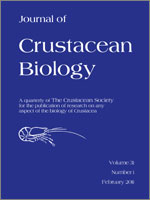Declines in abundance of the commercially important blue crab Callinectes sapidus have led fishery managers to search for new management strategies. Assessing year-class strength at megalopal or early juvenile stages may contribute to this effort, but separation from co-occurring species is difficult in many areas because morphological characteristics vary with season and published descriptions do not adequately distinguish C. sapidus from C. similis and other related species. Callinectes sapidus and C. similis megalopae were collected monthly and cultured in the laboratory to a size at which positive identification could be made. Measurements on intact megalopae and early crab exuviae of both species revealed seasonal differences, with spring megalopae having larger carapaces, longer rostral spines and antennae and more setae on some mouth parts than fall megalopae. This seasonal pattern of morphological variability was verified through examination of samples collected from MS (1976–1979) and NC (2005) coastal waters. Rostrum length, total carapace length and rostrum length as a percent of total carapace length of NC megalopae were negatively correlated with water temperature 2–4 weeks prior to collection.
Callinectes sapidus and C. similis megalopae can be rapidly separated within locations and seasons by: 1) the shape of the antero-lateral carapace margin, 2) rostral length as a percent of total carapace length, and 3) the combined length of the distal eight segments of the antenna. Such rapid separation is essential for fisheries studies requiring identification of large numbers of individuals. Molecular analyses or more detailed morphological analyses remain necessary for definitive separation regardless of season. Keys to common coastal portunid megalopae and first crab stages were compiled to aid investigators in separating C. sapidus megalopae and early juvenile stages from co-occurring portunids.





